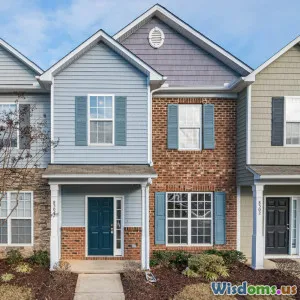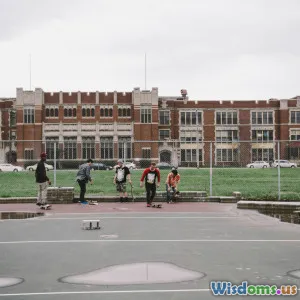
The Secrets Behind Successful Urban Bike Infrastructure
8 min read Discover what makes urban bike infrastructure successful with real-world examples and expert insights. (0 Reviews)
The Secrets Behind Successful Urban Bike Infrastructure
The hum of spinning wheels, the dash of bikers weaving through streets, and the visible decline in car congestion paint an inspiring picture of progressive cities. Yet, creating cityscapes that support widespread cycling is no accident—it's the result of careful urban bike infrastructure design and community trust. But what exactly makes bike infrastructure successful in urban settings? Let's unravel the secrets behind cities that have cracked the code.
Why Urban Bike Infrastructure Matters
Urban areas worldwide are under pressure to reduce traffic congestion, improve air quality, and foster healthier lifestyles. Bicycling stands apart as a sustainable, affordable, and healthy mode of transportation. However, cyclists need safe, connected infrastructure to confidently replace car trips with bike rides. Without proper lanes, parking, and integration with public transport, biking remains a niche activity rather than a mass transit alternative.
According to the Institute for Transportation and Development Policy (ITDP), cities with protected bike lanes have seen injury reductions by up to 40%. Amsterdam, with 38% of all trips made by bike, demonstrates how infrastructure can fundamentally shift a city's travel habits.
Components of Successful Urban Bike Infrastructure
1. Protected and Connected Bike Lanes
At the heart of successful bike infrastructure are protected bike lanes—physically separated from both cars and pedestrians. Evidence from cities like Copenhagen, Denmark, and Montreal, Canada, reveals that when cyclists feel safe, ridership soars. For example, Copenhagen’s “Cycle Superhighways” cover over 400 kilometers and serve as vital commuter routes.
Connectivity is equally vital. Bike lanes must form a coherent, continuous network. Patchy or fragmented lanes leave riders vulnerable and frustrated. Chicago, once criticized for inconsistent lanes, revamped its network into over 300 miles of connected paths, doubling bike trips between 2013 and 2018.
2. Safe Intersection Design
Intersections are hotspots for bike-car conflicts. Innovations such as dedicated bike signals, protected intersections, and bike boxes dramatically enhance rider safety. The city of Seville, Spain, despite its warm climate and newly invested infrastructure, employed safe intersection principles to experience a 600% increase in bike ridership in just five years.
Moreover, traffic calming measures—like raised crossings and curb extensions—slow car speeds, allowing drivers and cyclists to coexist safely.
3. Secure and Accessible Bike Parking
Convenient, visible, and secure parking reduces theft anxiety and encourages cycling for errands and commuting. Amsterdam boasts more than 60,000 bicycle parking spots, including multi-level garages at transit hubs, ensuring last-mile challenges don't deter riders.
Innovative systems, such as bike valet services and smart parking racks locked only by user apps, elevate the user experience.
4. Integration with Public Transport
Allowing cyclists to easily combine bike and transit trips extends a bike network’s reach. Cities like Berlin and Vancouver permit folding bikes on trains and provide bike racks on buses, blending flexibility with convenience. Infrastructure that supports these integrations, such as ample bike parking at transit stations, enhances convenience and expands options.
5. Inclusive Policy and Community Engagement
Effective infrastructure goes hand-in-hand with policy frameworks—bike-friendly laws, funding allocations, and promotional campaigns. Portland, Oregon, attributes much of its cycling boom to comprehensive policies and participation-focused planning processes involving residents and advocacy groups.
Equally crucial is community buy-in. Public workshops, pilot programs, and transparent feedback loops ensure designs reflect user needs and fears, fostering ownership and support.
Data-Driven Design and Maintenance
Successful cities continually use data to refine bike infrastructure. Sensors and bike counters gauge usage patterns, peak times, and popular routes to inform expansions or repairs. For example, the city of Paris analyzed data during their implementation of new bike lanes under the "Plan Vélo," increasing cycling trips by 35% within a year.
Additionally, maintenance guarantees long-term viability. Well-paved surfaces, timely snow removal, and well-lit lanes preserve safety and usability.
Challenges and How Top Cities Overcome Them
Balancing Space Allocation
In space-constrained cities, reallocating space from car lanes to bike lanes sparks debates. New York City navigated this challenge by phasing project rollouts, utilizing pop-up protected lanes initially to demonstrate benefits. This eased public acceptance and helped shape permanent solutions.
Addressing Equity Gaps
Infrastructure should not favor affluent neighborhoods only. Equitable investment ensures underserved communities gain access to safe biking options, improving overall social mobility and health outcomes. Minneapolis, for example, launched the "Bike Boulevard" program deliberately targeting lower-income areas to build connected routes.
Funding Constraints
Funding often limits ambitious projects. Public-private partnerships, grants from environmental agencies, and incremental implementation enable progress even when large lump sums are unavailable.
Inspiring Case Studies
-
Amsterdam, Netherlands: A century-long commitment to creating separated lanes, extensive parking, and cycling education made bikes the norm. Nearly 63% of residents use a bike for at least one trip per day.
-
Bogotá, Colombia: Through aggressive expansion of Ciclovía routes—temporary Sunday bike-only streets displaced from cars—public enthusiasm transformed into permanent investments in dedicated lanes and bike-share systems.
-
Copenhagen, Denmark: Known for its innovative "Green Wave" system, coordinated traffic lights ensure riders keep a consistent pace without frequent stops, encouraging biking as an efficient weekday commute mode.
Conclusion: Building for People, Not Just Bikes
The secret behind successful urban bike infrastructure lies in cities' willingness to reimagine streets as shared spaces that prioritize human scale, safety, and connectivity. It requires blending design excellence, data-driven policy, and community engagement.
As urban populations grow and environmental pressures mount, adopting these lessons can transform cities into vibrant, healthy, and equitable places. Every painted bike lane, secure rack, and protected intersection is a step toward sustainable urban futures—where cycling is not merely an option but a compelling, accessible choice for all.
The path forward is clearer than ever; it pedals through smart infrastructure and inclusive planning.
Ready to ride into the future? Advocate for your city’s cycling infrastructure — the journey towards sustainable urban living starts with a single pedal stroke.
Rate the Post
User Reviews
Other posts in Urban Planning
Popular Posts


















